Indice - Table of contents
Lo Nuevo[hide]
Musicos: Rafael Paseiro Monzón
Musicos: Dennis Nicles Cobas
Musicos: Jiovanni Cofiño Sánchez
Musicos: Yasser Morejón Pino
Fotos: Tom Ehrlich : 2024 Monterey Jazz, P...
Resenas: Vacilón Santiaguero (Circle 9 ...
Staff: Bill Tilford
Fotos: Tom Ehrlich : 2024 Monterey Jazz, P...
Fotos: Tom Ehrlich : 2024 Monterey Jazz Fe...
Fotos: Tom Ehrlich : testing 123
Grupos: Pupy y los que S... : Discography - 1995- F...
Reportes: From The St... : Cubadisco 2...
Reportes: From The St... : Jazz Plaza ...
Fotos: Tom Ehrlich : Irakere 50th Annivers...
Fotos Del Día [hide]
The Roots of Timba, Pt. III - 1983
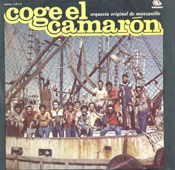 Original de Manzanillo released Coge el camarón. Manzanillo, a charanga with an added electric guitar, was fairly conservative both harmonically and rhythmically, but occasionally had some interesting breakdowns and bass work, such as the title track [source]. Perhaps the most influential aspect of the group was the improvisational vocal style of Cándido Fabré.
Original de Manzanillo released Coge el camarón. Manzanillo, a charanga with an added electric guitar, was fairly conservative both harmonically and rhythmically, but occasionally had some interesting breakdowns and bass work, such as the title track [source]. Perhaps the most influential aspect of the group was the improvisational vocal style of Cándido Fabré.
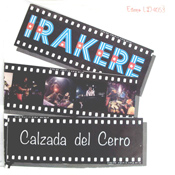 Irakere's Calzada de cerro had one extremely important pre-timba track -- El tata, (source - Vol. VII is currently unavailable).
Irakere's Calzada de cerro had one extremely important pre-timba track -- El tata, (source - Vol. VII is currently unavailable).
You can also find a great live version of this song on the Tierrazo DVD mentioned above.
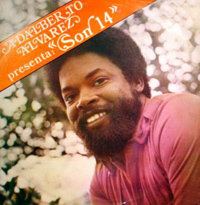 The conjuntos were also busy in 1983. Son 14 released its third album, Adalberto presenta Son 14, their last before Alvarez left to form his own group and probably their best. Agua que cae del cielo [source], with its Iyesá-based batá interlude, is even more adventurous that Bayamo en coche, and after hearing Adalberto play piano on these early recordings it's hard to imagine why he stopped. His horn arranging is also full of surprises. In this excerpt from El señor [write EGREM], he introduces bits of R&B phrasing that look forward to timba. It's ironic that Adalberto is now considered a traditionalist, working to preserve many stylistic elements of son in the face of the dramatic innovations of Klímax, Charanga Habanera, Bamboleo et al. But in the 80s it was Adalberto who was stretching the boundaries of son in every which way.
The conjuntos were also busy in 1983. Son 14 released its third album, Adalberto presenta Son 14, their last before Alvarez left to form his own group and probably their best. Agua que cae del cielo [source], with its Iyesá-based batá interlude, is even more adventurous that Bayamo en coche, and after hearing Adalberto play piano on these early recordings it's hard to imagine why he stopped. His horn arranging is also full of surprises. In this excerpt from El señor [write EGREM], he introduces bits of R&B phrasing that look forward to timba. It's ironic that Adalberto is now considered a traditionalist, working to preserve many stylistic elements of son in the face of the dramatic innovations of Klímax, Charanga Habanera, Bamboleo et al. But in the 80s it was Adalberto who was stretching the boundaries of son in every which way.
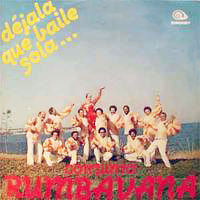 Meanwhile, the other leading conjunto, Rumbavana, released Déjala que baile sola, sticking with the classic instrumentation and harmonies but managing to sound modern with their raw aggressiveness and interesting rhythmic breakdowns.
Meanwhile, the other leading conjunto, Rumbavana, released Déjala que baile sola, sticking with the classic instrumentation and harmonies but managing to sound modern with their raw aggressiveness and interesting rhythmic breakdowns.
Among the highlights:
• The bell-playing. Timba and salsa bands have two interlocking bell parts. The bongosero plays a hand bell while the timbalero or drummer plays a "contracampana" pattern on a smaller bell and also plays fills on the timbales and cymbals to lead lead from one section to the next. In the case of the conjunto this responsibility falls on the bongosero who must create all that excitement with just one stick! The texture of the conjunto can be very refreshing to our jaded modern ears. Listen to this passage from En casa de Pedro el Cojo [write EGREM]. The bongosero's bell is to the left, the clave and congas in the middle and the güiro on the right. It's refreshingly simple mix and very easy to hear and feel the bell driving the band. Compare this to Revé which, in addition to having two bells, has three simultaneous guajeos while Rumbavana has only the piano. This isn't to say that one is preferable -- viva la diference! Understanding and categorizing these differences in the texture of the rhythm section is the ultimate goal of this 4-volume series. For now, just try to feel and appreciate the differences between bands, and between sections of the same song.
• The breakdowns. There are many answers to the standard questions: "What is timba? Why is it different from salsa?". For me, the most satisfying is that in timba, each band has a style or "sello" consisting of a special repertoire of rhythm section breakdowns which it uses in multiple songs. In the period we've been studying, we're already finding some of this. For example, on most Ritmo Oriental songs, we can find a place where the piano, strings and bells drop out, while the bass, güiro and congas continue. More often, as is the case with Rumbavana, there may or may not be a breakdown and if there is, it's a special one for just that song. Here are some of the more interesting ones on this album:
• Que baile sola el son -- Breaks down to clave and bass (doubled by piano) with bloques.• Como vivo yo -- Breaks down to only percussion, playing some sort of wild comparsa. The intensity of the percussion, coupled with the falling envelope of the bass drum, can be heard as an ancestor of timba's "bomba" gear.• No llores no vuelvo -- With the sliding bass this one is even closer to the timba "bomba" gear. After that section, it goes to another breakdown - clave, piano and bass, with bloques. If not for the bass, this would be very much like the timba "pedal" gear.
• Rumbavana's "bachata-guaguancó" style. There are two such tracks. In addition to having passages of straight guaguancó, the full-band sections incorporate the paila, or guagua pattern in place of the güiro. Listen to this passage from Como vivo yo. The bell is on the left and the guagua is on the right.
Among the straight guaguancó sections, Que baile sola el son is exceedingly unusual one in terms of clave. From the early 50s onward, guaguancó has been played such that the characteristic 4-note melody of the congas falls on the 2-side of the clave, creating a "call and response" relationship with the clave.
xx0x 0xxx 0xx0 xxx0 2-3 rumba clave
HxxH xxLx xxxx xxLx conga melody (H=high; L=low)
The underlined 0's of the clave answer the underlined H's of the congas.
example 1: Los Muñequitos de Matanzas: La gitana, [source]
example 2: Los Van Van: De la Habana a Matanzas, [source]
example 3: Rumbavana: Como vivo yo, [write EGREM]
What's so unusual is that on Que baile sola el son [source], the conguero comes in "on the wrong side". But it can't be a mistake. This conguero, whose name we don't have, plays 'is bloomin' arse off throughout the album, and, later in the album, plays the part "on the right side" on Como vivo yo. In short, there's no way that this was a careless mistake. It's a studio album and someone would have caught it, so it has to be intentional. The question is ... why? Send in your theories if you have them!
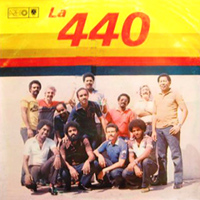 Orquesta 440 was yet another band to be formed by musicians splitting off from Revé. This time the principals were Pepe Maza (Michel's dad), Armando "Andy" Gola (who later founded Colé Colé) and Germán Velazco who later went to Irakere and then NG. The group was founded in the late 70s but the first recording we've found was La 440 from 1983. This band had a very unusual instrumentation with violins, flutes, trumpets and saxes. A lot of the tracks sound like easy-listening jazz, but like Irakere, la 440 could really bring it when so inspired.
Orquesta 440 was yet another band to be formed by musicians splitting off from Revé. This time the principals were Pepe Maza (Michel's dad), Armando "Andy" Gola (who later founded Colé Colé) and Germán Velazco who later went to Irakere and then NG. The group was founded in the late 70s but the first recording we've found was La 440 from 1983. This band had a very unusual instrumentation with violins, flutes, trumpets and saxes. A lot of the tracks sound like easy-listening jazz, but like Irakere, la 440 could really bring it when so inspired.
Que siga la tradición [source] has a great coro which Tosco reinvented six years later for NG La Banda's Por que tú sufres [source]. Temas diarios [source] is another strong track with an interesting breakdown approach and a coro that's borrowed from la Ritmo's Así no se vale [source].
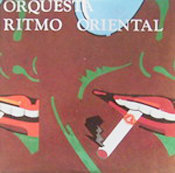 Ritmo Oriental -- In addition to becoming the main lead vocalist Tony Calá also wrote half of the songs on la Ritmo's 1983 album, El agua me llevó. In our first clip [source], Tony recounts a humorous story which could easily have turned tragic when the band was caught in a torrential storm and the musicians had to stand on top of the tour bus to keep from drowning. They lived to tell the tale and turned it into a great song, complete with sound effects and -- as always -- brilliant bloques and rhythm section playing. The string-writing (remember that Calá was also a great violinist) is also very creative on this album. Another violinist-arranger who participated in this album was David Calzado, who had come over from Revé (where else?). In addition to arranging Mi amigo Nicolás, Calzado was busilyy absorbing many influences - both rhythmic and choreographic - which he'd put to use 10 years later with Charanga Habanera. It's often said that CH modeled their stage show after Earth Wind & Fire, but if you watch early videos of la Ritmo, it's clear that much of his inspiration came from influences that were much closer to home.
Ritmo Oriental -- In addition to becoming the main lead vocalist Tony Calá also wrote half of the songs on la Ritmo's 1983 album, El agua me llevó. In our first clip [source], Tony recounts a humorous story which could easily have turned tragic when the band was caught in a torrential storm and the musicians had to stand on top of the tour bus to keep from drowning. They lived to tell the tale and turned it into a great song, complete with sound effects and -- as always -- brilliant bloques and rhythm section playing. The string-writing (remember that Calá was also a great violinist) is also very creative on this album. Another violinist-arranger who participated in this album was David Calzado, who had come over from Revé (where else?). In addition to arranging Mi amigo Nicolás, Calzado was busilyy absorbing many influences - both rhythmic and choreographic - which he'd put to use 10 years later with Charanga Habanera. It's often said that CH modeled their stage show after Earth Wind & Fire, but if you watch early videos of la Ritmo, it's clear that much of his inspiration came from influences that were much closer to home.
The song that was performed most live was another Calá composition, Barrios de los rumberos. Clocking in at over 6 minutes, it goes goes through many changes -- starting with a beautiful cuerpo set against a guaguancó and then transitioning in a very unique way to the first coro [excerpt 1 - source]. The energy keeps building into the first coro [source], during which Tony quotes la Ritmo's first big hit, Sabroseao con la Ritmo, and with the second coro, the violins take up a guajeo that launches the track into a transcendental groove ... none of the people we've found who were lucky enough to hear this song live came away from the experience unchanged!
Last but not least we come to yet another Calá composition, Conmigo candela brava. The introduction [source] juxtaposes a funky shuffle bassline with its folkloric ancestor. The 12/8 groove returns after the first coro. The second coro is an early example of the technique of two overlapping coros, later put to great use in the timba era.
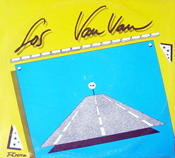 There's a fascinating episode of the Cuban television show Mi Salsa, in which El Tosco, Changuito and others engage in a spirited debate over the relative merits of the music of the 70s and 80s. If nothing else, the 80s brought one undeniable improvement -- the idea of giving albums titles! It's wonderful to be able to call Los Van Van's eighth album Pistas instead of "Volume VIII".
There's a fascinating episode of the Cuban television show Mi Salsa, in which El Tosco, Changuito and others engage in a spirited debate over the relative merits of the music of the 70s and 80s. If nothing else, the 80s brought one undeniable improvement -- the idea of giving albums titles! It's wonderful to be able to call Los Van Van's eighth album Pistas instead of "Volume VIII".
If LVV had hung up their spurs in 1990, their most famous song would no doubt have been Por encima del nivel, better known as Sandunguera [source for all exceprts]. It's a testament to the greatness of the 90s band that while LVV had 14 songs in the timba.com readers' awards, including the top 2, Sandunguera didn't make the list. Nevertheless, it's a great song and was the biggest hit of their first 20 years. It's also a source of endless fascination and debate for clave geeks of all ages.
The other major hit was Qué palo, sung by Formell himself. Ay mamá recíbeme was covered by Paulito on the Gracias Formell album. If the electronic percussion on Qué pista sounds dated, Changuito's rhythms, especially the kick drum, continue to be years ahead of their time.
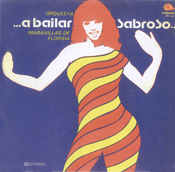 November: Maravilla de Florida released A bailar sabroso. Their style had changed quite a bit from the distinct cha-onda flavor of their 1980 album. The piano was usually now decoupled from the bass and the texture of the band was denser - more like Ritmo Oriental than late-70s Aragón. And the new pianist was a very significant addition. Manolito Simonet, ten years later, would form one of the most important groups of the timba era. In 1983, he was already an extremely polished musician as evidenced by his lengthy solo on Caras extrañas [source].
November: Maravilla de Florida released A bailar sabroso. Their style had changed quite a bit from the distinct cha-onda flavor of their 1980 album. The piano was usually now decoupled from the bass and the texture of the band was denser - more like Ritmo Oriental than late-70s Aragón. And the new pianist was a very significant addition. Manolito Simonet, ten years later, would form one of the most important groups of the timba era. In 1983, he was already an extremely polished musician as evidenced by his lengthy solo on Caras extrañas [source].
Los Maravillas, like Típica Juventud, used its string arrangements to experiment with some very unusual harmonies, as in our second example, Oye consejo [write EGREM]. Driven by percussionist/composer Eladio Terry, they were also pushing the upper limits of tempo. Terry's Rafael y el catarro [write EGREM] maxes out at 144 bpm! Again, note that the monopoly that 2-3 clave enjoyed in the 70s has come to an end. By the mid-80s 3-2 was being used quite often by Maravilla, Van Van, Adalberto and others.























